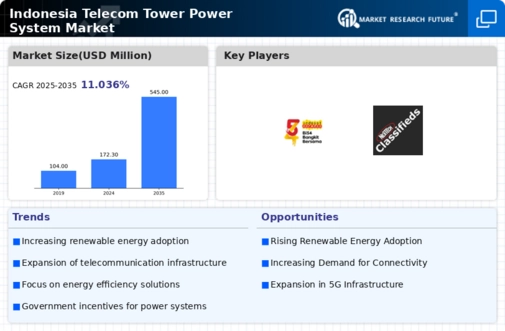Growing Focus on Energy Efficiency
The growing focus on energy efficiency within the telecom sector is a significant driver for the telecom tower-power-system market. As energy costs continue to rise, telecom operators are increasingly prioritizing energy-efficient solutions to minimize operational expenses. This trend is evident in the adoption of advanced power management systems and energy-saving technologies. Reports suggest that energy-efficient systems can reduce power consumption by up to 25%, which is particularly crucial in a market where profit margins are under pressure. Consequently, the emphasis on energy efficiency is likely to stimulate demand for innovative power solutions, thereby propelling growth in the telecom tower-power-system market.
Rising Demand for Mobile Connectivity
The increasing demand for mobile connectivity in Indonesia is a primary driver for the telecom tower-power-system market. With a population exceeding 270 million, the need for reliable and extensive mobile networks is paramount. As urbanization accelerates, more individuals rely on mobile devices for communication, work, and entertainment. This trend is reflected in the growth of mobile subscriptions, which reached approximately 370 million in 2025. Consequently, telecom operators are investing heavily in expanding their infrastructure, including the deployment of new towers and power systems to support enhanced network capabilities. This surge in demand necessitates efficient power solutions to ensure uninterrupted service, thereby propelling the telecom tower-power-system market forward.
Increased Competition Among Telecom Operators
The competitive landscape among telecom operators in Indonesia is intensifying, which serves as a catalyst for the telecom tower-power-system market. As operators strive to differentiate themselves, they are investing in advanced technologies and infrastructure to enhance service quality. This competition has led to a surge in the deployment of new towers and power systems, as companies aim to expand their coverage and improve network reliability. Market data indicates that the number of telecom towers in Indonesia is projected to grow by 15% annually through 2025. This competitive environment not only drives innovation but also necessitates efficient power solutions to support the expanding network infrastructure.
Technological Advancements in Power Solutions
Technological advancements in power solutions are transforming the telecom tower-power-system market. Innovations such as energy-efficient power systems and smart grid technologies are becoming increasingly prevalent. These advancements not only reduce operational costs but also enhance the reliability of power supply to telecom towers. For instance, the integration of solar power systems is gaining traction, with estimates suggesting that up to 30% of new installations in 2025 may incorporate renewable energy sources. This shift towards more sustainable power solutions is likely to attract investments and drive growth in the telecom tower-power-system market, as operators seek to optimize their energy consumption and reduce their carbon footprint.
Government Initiatives for Infrastructure Development
The Indonesian government has been actively promoting infrastructure development, which significantly impacts the telecom tower-power-system market. Initiatives aimed at improving connectivity in rural and underserved areas are gaining momentum. The government has allocated substantial funding, estimated at $1 billion, to enhance telecommunications infrastructure, including the installation of new towers and power systems. This investment is expected to facilitate better access to mobile services, thereby increasing the overall market size. Furthermore, the government's commitment to fostering a digital economy aligns with the expansion of telecom networks, creating a favorable environment for the telecom tower-power-system market to thrive.













Leave a Comment